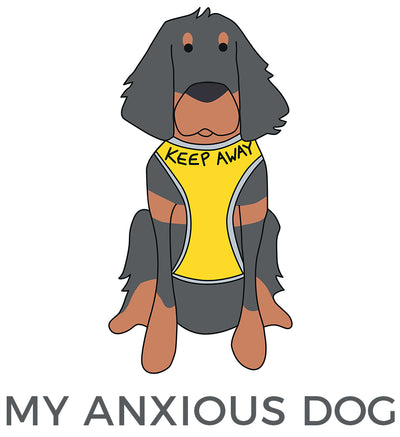I often come across people who don’t have children or have children in their family, so they might not know how to deal with children who come over to try to pet their anxious or fearful dog.
As responsible dog caregivers, they get their dogs to wear a yellow harness and maybe they are also using a yellow lead, but this doesn’t seem to stop excited kids from falling in love with the dogs in yellow. And, let’s face it, who can blame them? After all, a dog wearing yellow items is still super cute, fluffy, and too adorable to pass by, right?
What we ought to remember is that children will view dogs in yellow the same way they see any other dog, however, what we can do is change how they act around dogs, all dogs.
At Kids Around Dogs®, we aim to help children respect dogs and to learn about basic canine body language, so they can understand when a dog is happy to have a play or a cuddle and when they prefer to be left alone. We do this by doing school talks, or workshops, and working with families.
However, if you are a dog guardian at the park and children make a beeline for their dogs in yellow, it can be rather tricky. So, what should you be doing?
The answer is much simpler than you’d think… Be Honest!
I think we don’t give children enough credit, because they are clever little humans, and they will understand if something is explained to them in simple and short sentences. The main difference between children and adults is that they might have to be told multiple times before something really sinks in.
So, if you are out and about with your dogs in yellow and kids want to come over and touch your dog, don’t simply ask them not to, or to move away, but tell them what’s going on with your dog and suggest something they can do instead.
Let me give you an example of how a conversation could go.
‘Hi, my dog is scared of [add what your dog is scared of], so it is best if you stay 4 or 5 steps away. Do you see this yellow harness/lead/etc? It means that he is a dog that needs some space because they are a little scared. But you can blow a kiss at my dog if you want.’
If a parent is nearby, carry on repeating the same thing to the parent as well. You would do so to make sure the parent knows exactly what the situation is, but also to repeat it for the children.
If the children are still lingering and are not sure whether they are ready to give up on petting your dogs in yellow or not, you can demonstrate how they can wave or blow a kiss to your dog.
While sometimes walk away can be a good idea, it is always best to have the children walking away first. This is to avoid the kids sneaking a quick back or tail stroke as you move away.
What about parents? What can parents do to help their children understand that not all dogs enjoy being touched?
My Anxious Dog is such a great association and is spreading the word more and more about the meaning of seeing dogs wearing yellow items, so why not use some of their posters to show the kids?
This is a great poster to show the kids that, dogs wearing yellow in particular, need space.

Just like a dog caregiver, you, parents, ought to be honest with your children and tell them about the fact that some dogs are scared of people, or other dogs, or many other things. When we come across those dogs, we want to make sure we give them the space they need, so that they can feel happy and safe.
Suggest something safe they can do for the dog, like blow a kiss to him or say, ‘Hello Doggy!’ from a distance.
Can they say ‘Hello’ in another language? It might be fun to practice some French, which they are likely to learn at pre-school and school.
What about thinking of a friend or a family member who looks like the dog in yellow? It might be fun to tell Uncle Brian that they met a Cocker Spaniel at the park that looked exactly like him today!
As mentioned before, children might forget what we tell them, so you might have to repeat yourself a few times, that is why it might be a good idea to print the infographic above and stick it to your fridge, or other places which are easily spotted by the kids on a daily basis.
I love to encourage activities and connections between dogs and kids, however, those connections need to be positive for both species, so that the interactions can be fair, fun and safe.
By educating kids about dogs wearing yellow items, we can avoid many difficult situations and have happier dogs and more responsible little humans.
For more information about Kids Around Dogs® or to find your local KAD Approved Professional, please visit: www.kidsarounddogs.co.uk


